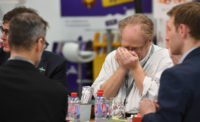Steve Blue, president and ceo of Miller Ingenuity and author of the forthcoming book, American Manufacturing 2.0: What Went Wrong and How to Make It Right, likes to use Blockbuster as an example of a company that became too comfortable.
Instead of preparing for the future, Blockbuster thought it could forge ahead sticking to what had been a perfectly valuable formula: renting out VHS tapes and then subsequently DVDs through thousands of retail locations scattered across the United States. Along came Netflix, and in a few short years, blew up the business model through the use of technology. Blockbuster went bankrupt in 2010 while Netflix posted $41 billion in revenue last year.
Add a bit of irony to the tale; Netflix proposed that Blockbuster purchase them in 2000.
As Blue points out, “One thing is for certain: If your company isn’t innovating, all of its products or services eventually become commodities. Or they’re toppled by the next Netflix.”
So how, exactly, do one spark new innovation at a company? What’s more, how does one do it at an already established business? Blue offers some suggestions:
- Make innovation part of everyone’s job description, he says. From the plant floor to the executive door, mandate that the entire organization offer ideas to improve products and services.
- Invest in innovation. Blue suggests training every single employee in the principles of brainstorming and innovation.
- Provide the time to innovate. But here’s the rub. Blue believes 20 percent of an employee’s time should be spent “thinking about things,”, which is really just as important as “building things.” Of course, that could mean hiring more people to handle the work load.
- Provide the space to innovate. Once you’ve established the practice of innovation, devote a location within your organization where they can meet regularly and without interruption, the executive says.
- Celebrate, recognize and reward innovation. By celebrating and recognizing innovation every opportunity possible, word gets out, attitudes change. This has a way of transforming workplace culture for the better and reinforcing positive behaviors.
- Fight fear and resistance. Innovation is no longer an option — it’s a necessity. As one moves the business toward more innovative thought, one should be prepared for some pushback. Also, the ceo must be ready to restructure the organization and even cut people loose if necessary. It’s critical to surround new developments with people who believe in innovation. Otherwise, a company’s left with naysayers and those who’ll do little more than look for flaws.
In that spirit, Candy Industry’s Leaders in Innovation section provides insights on the subject from leading confectionery processing and packaging equipment suppliers. Fostering an environment that begets innovation requires a combination of open-mindness and discipline, incubation and inspiration. Given today’s marketplace, where manufacturers must continuously deliver sweets that are indulgent and evocative, fun and filling, better-for-you and blissful, suppliers are taken to task to help create these products. The cycle is unending. And yet, despite these challenges, so are the innovations.
Heinz Soldat, chief executive officer and technical director
Fasttrack Engineering: Experience, expertise helps exceed expectations
FastTrack Engineering is a relatively new company in the mogul business; nevertheless, the equipment manufactured by the company has been in the making for several decades by the company’s founder, Heinz Soldat.
The company has designed and manufactured what other mogul manufacturers have classified as not feasible, by creating a mogul that has a linear motion pumping system, with the tray lift occurring during the depositing process. This creates a deposit equal to a stationary pump.
As such, this depositing process will save the end user a considerable amount of investment when purchasing a new mogul. It also reduces washout of the pumping system and improves changeovers from one product to the next.
Typically, the least number of moving parts within a machine provides the best operational conditions. This can only be achieved through the use of servo motors, positioning them as close as possible to the source, which needs to be controlled.
The two-stage tray turn mechanism, engineered into all of our moguls, has proven to be an extremely effective and accessible mechanism. It can be easily maintained, the clamping of the trays achieved by self-centering, pneumatically operated mechanical clamps. The clamps hold the tray central over the full width of the tray and support the tray sideways, thus eliminating slippage of the tray.
Fasttrack Engineering, is manufacturing the full range of all mogul-related auxiliary equipment, including starch conditioning system, pallet transportation and fully computerized drying rooms.
The company is using the latest technologies available to the industry, our engineers continuously striving to develop and incorporate these technologies to improve our equipment.
In addition, we also have been designing and manufacturing customized equipment for our customers. Our goal is to develop products that exceed the customer’s original expectations, continuously focused on providing the best possible solutions for them.
For more information, visit www.ftengineering.com.au
Frank Temme, co-managing director
Hänsel Processing: R&D at the heart of innovation
Hänsel Processing GmbH is known worldwide for its outstanding experience and expertise in supplying high quality and innovative confectionery processing equipment. For more than 100 years Hänsel has provided service and machinery for the confectionery industry.
“We constantly strive to keep up with the customers´ most up-to-date demands and that is why we dedicate a huge amount of time and money in R & D,” says Frank Temme, co-managing director of Hänsel Processing.
“Our close working relationships with customers, particularly in listening to and addressing their demands, also allows us to address the topic of sustainability, which is becoming more and more important in the worldwide confectionery industry market,” he continues.
Besides, the company’s traditional and at the same time highly innovative and economical machines are designed for a maximum of productivity. What counts today are short changeover times, long maintenance intervals and uncomplicated, fast customer service.
Traditionally, machines have been built in rectangular frame design. Hänsel Processing is now changing the design to a round tubular design for all machine frames because of a slight increase in demand. Many customers, however, still prefer rectangular design, because all utility and product piping is round and the rectangular framework provides a difference to them.
A user-friendly design guarantees continuous high outputs, not only for high quality hard candies (center-filled, aerated, laminated, milky, sugar-free, medicated, specialities), but also for all kinds of other sugar products, including jellies & fondants (gelatin, agar agar, pectin, gum arabic, starch, fondant crème, bakery fondant, milk fondant, fruit fondant), toffees (milk caramel, éclair, fruit candies, chewy candies, caramel layers, specialities), and bars (foam sugar, candy bars, granola, torrone, halwa).
When it comes to gums and jellies, the company scored a breakthrough with regard to producing the best products, even with nutritional value. Post-adding stations for non-thermo stable ingredients, in powder or liquid, work well in high capacity production lines, even when operating at more than 12,000 lbs./hour. The JellyStar cooking line, appropriate for all common jellying agents, is characterized by a compact design. It offers the possibility to produce high- quality, aerated and transparent jellies with HPG machines even if space is limited. The JellyStar cooker also can be integrated in existing plants.
For more information, visit www.haensel-processing.de
Christian Werner, general sales director
Hebenstreit: Excellent engineering equals delicious results
Since decades Hebenstreit is known to setting the standards in wafer production technology. In the early 80’s Hebenstreit launched the revolutionary new plate size of 700 x 350 mm. This is still today’s standard and many of these high capacity wafer production lines are in operation, worldwide. This development was also paired with the introduction of the vertical hook locking system, which is the most advanced locking technology and appreciated by many wafer manufacturers around the globe.
Today Hebenstreit is presenting the next step in wafer technology, the 1,000 x 350 mm wafer plate, the largest size ever! This means the highest capacity and efficiency on a minimum floor space.
Additionally, Hebenstreit’s focus has been in developing equipment to meet the needs of modern users by reducing capital costs, reducing ongoing operational costs, increasing efficiencies, and reducing the environmental aspects of wafer line operations. To achieve these objectives Hebenstreit have concentrated its efforts in a number of specific areas. The introduction of new burner technology, combustion chambers and air exhaust systems has led to a 20 percent reduction in oven gas consumption. Moreover, these measures have also led to a 60 percent reduction in CO2 emissions.
However, it is not only the wafer line that has benefitted from recent developments. Hebenstreit has developed a system of automatically fully opening and closing the baking plates at the rear of the oven and then using a laser to quickly and efficiently clean the plates. This method allows for a complete oven to be cleaned in a single shift, is fully automatic after set up and ensures superior plate cleaning with minimal environmental impact.
Hebenstreit also recognizes that a good quality wafer starts with a good quality batter. Following the acquisition of new designs and staff to supplement its own range of equipment, Hebenstreit is now in a position to offer an extensive range of batter preparation equipment from simple, manually fed batter mixers up to fully automatic systems with automatic dry goods handling systems, automatic feeding of dry and wet ingredients, mixing, resting and feeding systems to one or more ovens.
Based on the former know-how and the input of additional expertise in food extrusion, the company has also developed a series of complete state-of-the-art extrusion lines for the manufacturing of savory and sweet snacks as well as breakfast cereals. Depending on the recipes and the sensory characteristics, the capacities of the lines range between 200 to 800kg/h of finished product.
As a result, it’s no surprise that many of the worldwide popular wafer and snack food products are made with Hebenstreit’s technology and support.
For more information, visit www.hebenstreit.de
Miriam van Dijk, managing director
Royal Duyvis Wiener: One-stop-shopping from bean to bar!
The Royal Duyvis Wiener group, sole global supplier of cocoa and chocolate processing equipment from bean to bar, is constantly moving forward by innovating and expanding its business. The globalization of our company is a steady, on-going process and we are able to serve and support our customers from several locations around the world with the highest quality standards they have come to expect during our 130 years of service.
In January, Royal Duyvis Wiener B.V. opened a 2,000-sq.-meter state-of-the-art Technology Center. Having a R&D area, a pilot plant for trials and product development up-scalable to production size for all technologies within the group, customers are able to test and analyze their new products.
Either for cocoa, chocolate or nuts, trials can be performed, recipes developed and last but not least, analytical comparisons can be made between all different production methods available in the market.
This Dutch Technology Center is the only cocoa and chocolate experience in the world where all different technological solutions are available and are at a customer’s disposal for comparison and recipe development.
As for Log5, our dedicated process technologists will be able to show customers everything about dry food processing pasteurization, sterilization, roasting, grinding, refining and hydraulic “prime” pressing. The unique Log5 system can pasteurize all kinds of dry products, using an atmosphere with precisely controlled water activity and temperature.
Royal Duyvis Wiener’s dedicated staff all around the globe looks forward to translating customer challenges into profitable solutions through its processing equipment!
For more information, visit www.duyviswiener.com
Ralf Schäffer, executive vice president
Sollich KG: R&D investments optimize innovative developments
Sollich KG represents innovative and comprehensive solutions for chocolate and confectionery production. The product range covers equipment for most chocolate, confectionery, snack and bakery applications including enrobing, tempering and cooling as well as bar and praline center forming.
One highlight is the Turbotemper Top tempering machine available in various sizes and executions. The on-going development of the Flex Temper and the cleaning device allows an optimum use of the machine adapted to consumption requirements when using different chocolate and filling masses. Therefore, oversized tempering machines and high energy consumption are history. In combination with these tempering systems various sieving, mixing and flavor dosing systems round out the program.
The new developed enrobing lines type Sollcoater SC and SCT with working widths between 520 and 820 mm as well as the Conbar line and Sollcocap line demonstrate that the company is investing significant resources and effort into its R&D center to continuously optimize the equipment. Besides innovations to improve the processing technology, Sollich’s R&D department focuses on energy saving, hygiene and increased overall efficiency of the production lines.
The company has also developed a new Sollcocap Sandwiching System for a refined finishing process of biscuits with viscous fillings like caramel, fondant, nut paste, jelly, milk and yogurt cream or chocolate. The improved execution of the high-performance and specific depositing systems allows extremely precise production of biscuits with fillings or of sandwich biscuits.
The highest and most famous platform to show such new innovations is interpack, which will take place from May 4-10, 2017 in Duesseldorf. Once again, Sollich will demonstrate its leading position as an innovative machinery supplier in the global confectionery industry.
Amongst the many innovations planned for the show, such as new tempering machines, enrobers, cooling tunnels and a praline center-forming machine, there will be a great many additional improvements to the complete product range on display.
However, innovation does not stop at the development of machines and processing techniques. A great deal of innovation has also been devoted to the production facilities in order to build the machines in a more efficient and flexible way. By expanding the factory site by nearly 40 percent, the machines are built in the most modern way to guarantee first-class quality as well as flexibility.
The customer service offered by Sollich is known to be one of the best worldwide. Now it can be supported by the newly developed Sollich “Fast Lane” Online Support to speed up the start-up of production lines as well as provide customers trouble-shooting online on very short notice.
For more information, visit www.sollich.com.
Bruno Porro, managing director
TECNO 3: Continuous improvement through cooperation
Since 1988, TECNO 3 manufactures cutting-edge lines for the complete processing of chocolate and fat-based creams as well as equipment for the melting of fats and solid masses.
TECNO 3 designs and engineers its machinery based on the ingredient’s properties and its processing requirements in order to get the utmost highest quality in the final product.
As a result of effective and consistent cooperation with its customers, the company realizes that today’s marketplace calls for flexible and versatile lines, lines that are easily cleaned while offering maximum flexibility and minimum downtime during production changeovers. To answer this challenge, TECNO 3 has developed its lines by using continuous process technology.
The company’s technicians and technologists constantly strive to keep up with new applications and concepts that make its processing lines second to none when it comes to continuous processing and quick production changeovers.
The company’s testing laboratory provides customers the possibility to run trials with their products. In fact, the whole processing cycle can be reproduced, beginning with cocoa bean roasting and continuing through the end product to be moulded.
The passion for such work is the driving force that leads our customers, our technologists and technicians to aim for continuous enhancements, further strengthening the company’s desire to grow.
Next year TECNO 3 will enlarge its production facility with the addition of a new testing laboratory. By building a new test laboratory as part of the company’s on-going enlargement of its production facilities, the investment enables TECNO 3 to keep in step with the latest market needs.
For more information, visit www.tecno-3.it.
Rainer Runkel, managing director
Winkler und Dünnebier Süßwarenmaschinen: The power of innovation triggers solutions
Winkler und Dünnebier Süßwarenmaschinen GmbH (WDS) has a record of more than 100 years in engineering confectionery machines known for their quality and flexible modular design.
“Thanks to our Product Innovation Center, we are today a solution partner, providing all services to transform a product idea into a successful product launch,” says Rainer Runkel, WDS’s owner. And furthermore: “Most projects start at the Innovation Center where our team of food scientist tests new product concepts using the WDS lab depositors. If the new product idea challenges our standard equipment, our in-house engineering team is keen to find new technical solutions.”
With its comprehensive machinery and production portfolio, WDS has the capability to cover the whole spectrum of deposited confectionery products. The company is experienced in the production of jellies and gums as well as licorice, fondants, creams, marshmallow foams and similar masses.
For most customers, WDS mogul lines for the production of jellies, fondant and toffee are the first choice. For those looking to leave the complexity of a starch-based process behind, the WDS starchless line is the alternative. For the production of standard hard-candy products, WDS offers the line type 165 using aluminum moulds.
When it comes to chocolate production, the company services small to large-sized businesses with capacities from 200 kg/h to 7,000 kg/h. The machines can even combine two fillings in one shell with a one-stroke deposit thanks to the company’s Triple-Shot technology.
A core WDS expertise is the traditional orbital shell moulding or stamping of fine, thin chocolate shells using its FSC Flash Shell Cooling station. The newest family member in WDS’ fleet of machines is the ConfecECO – a start-up line for the production of plain, center-filled bars, pralines and masses with inclusions.
“Our goal is to accompany the companies from the product idea to product launch and beyond in order to help them to growing their business,” Runkel emphasizes. “With the launch of ConfecECO, we are approaching rapidly growing markets with start-up companies and can address the needs for small and medium-sized businesses.”
For more information, visit www.w-u-d.com.






